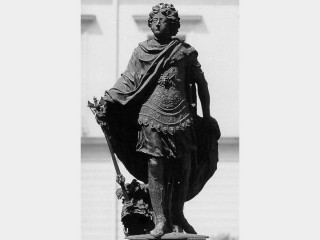
Andreas Schlüter biography
Date of birth : -
Date of death : -
Birthplace : Hamburg, Germany
Nationality : German
Category : Arhitecture and Engineering
Last modified : 2010-11-29
Credited as : Sculptor and architect, the Great Elector,
Andreas Schlüter (ca. 1660-1714), German sculptor and architect, was the greatest exponent of the baroque style in northern Germany. His works are characterized by powerful, dynamic forms and great dignity.
Andreas Schlüter whose exact birth date is uncertain but which must have been in the early 1660s, came from the north of Germany, probably Hamburg or Danzig. Little is known of his early training. He worked in Warsaw as a sculptor (1689-1693). In 1694 he was working in Berlin as a sculptor, apparently called there by the prince-elector of Brandenburg, Frederick III, who later became King Frederick I of Prussia. In 1695 Schlüter was sent on a brief study trip to France and, in 1696, on one to Italy at the expense of the elector. Later that year Schlüter produced statues for the Long Bridge leading to the palace in Berlin, as well as over 100 decorative heads of warriors for the keystones of the arches of the Arsenal in Berlin. These heads were largely produced by his assistants after his models.
In 1696 Schlüter began his designs for the bronze equestrian monument to the King's father, the Great Elector, his most famous work in sculpture. This overlife-size statue was executed between 1698 and 1700, and the four enchained warriors, symbolizing the four temperaments, at its base were completed in 1708. The monument was originally
on the Long Bridge, but after World War II it was placed in front of the Charlottenburg Palace. Inspired by such monuments as the Marcus Aurelius on the Capitol in Rome and Francois Girardon's equestrian statue of Louis XIV, the monument of the Great Elector is noteworthy for its great vitality and movement. Yet the dynamism of its large forms is more reminiscent of Gian Lorenzo Bernini than the aforementioned classical or classicizing examples.
In 1699 Schlüter was appointed surveyor general of works for the elector, in charge of all buildings, and began work on a new palace on the island in the Spree, the famous Berlin Schloss. For it he designed not only the massive block of the structure itself but also all decorative details and the interiors. His organizational abilities were as important as his architectural talents in this enterprise, for he held the same sort of position in Berlin during the first decade of the 18th century that Bernini had earlier held in Rome, controlling all aspects of every architectural undertaking.
The construction of the Schloss was under Schlüter's direction until 1707, after which work continued under his successors, such as Eosander von Gothe. Those parts that were after Schlüter's designs were the Great Court, the Great Portal, and the main rooms of the first floor. All revealed Schlüter's basically sculptural approach to architectural problems: his tendency to enliven large areas through the dramatic use of strongly projecting articulating elements. The sculptural decoration of the stairway and the ceiling of the Hall of the Knights (Rittersaal), representing the four continents, were also his. The Schloss, although less damaged during World War II than many other buildings in Berlin, was the victim of political considerations and was demolished by the East German authorities in 1950. Only the sculpture is preserved (Bode Museum, Berlin).
In Berlin, Schlüter also designed and executed such works as the pulpit in St. Mary's Church (1703), the Alte Post (1701-1704; destroyed in the late 19th century), and the Münzturm (1706), a water tower attached to the Mint. The imminent collapse of this tower, and the discovery of structural problems in his other buildings, notably the Arsenal, led to the downfall of the architect. Although he demolished the water tower himself and sought to justify his errors, his enemies at court thoroughly discredited him. He lost one office after another and became seriously ill. By 1710 he was in disgrace at court and was permitted to work only as a sculptor. The sarcophagus of the elector (1713) was his last important work in Berlin.
In 1714 Schlüter left for St. Petersburg, where he had been offered employment. He died there the same year shortly after his arrival.
The standard monographs on Schlüter are in German. In English only Eberhard Hempel, Baroque Art and Architecture in Central Europe (1965), deals with the artist to any degree.
















